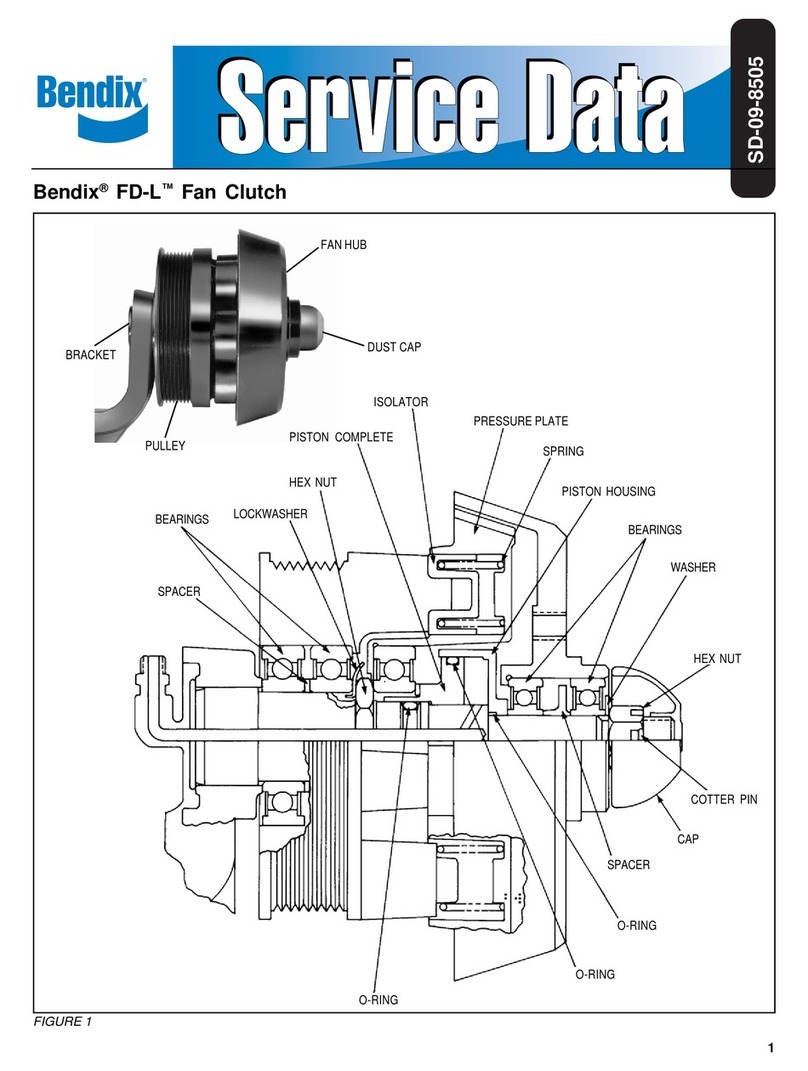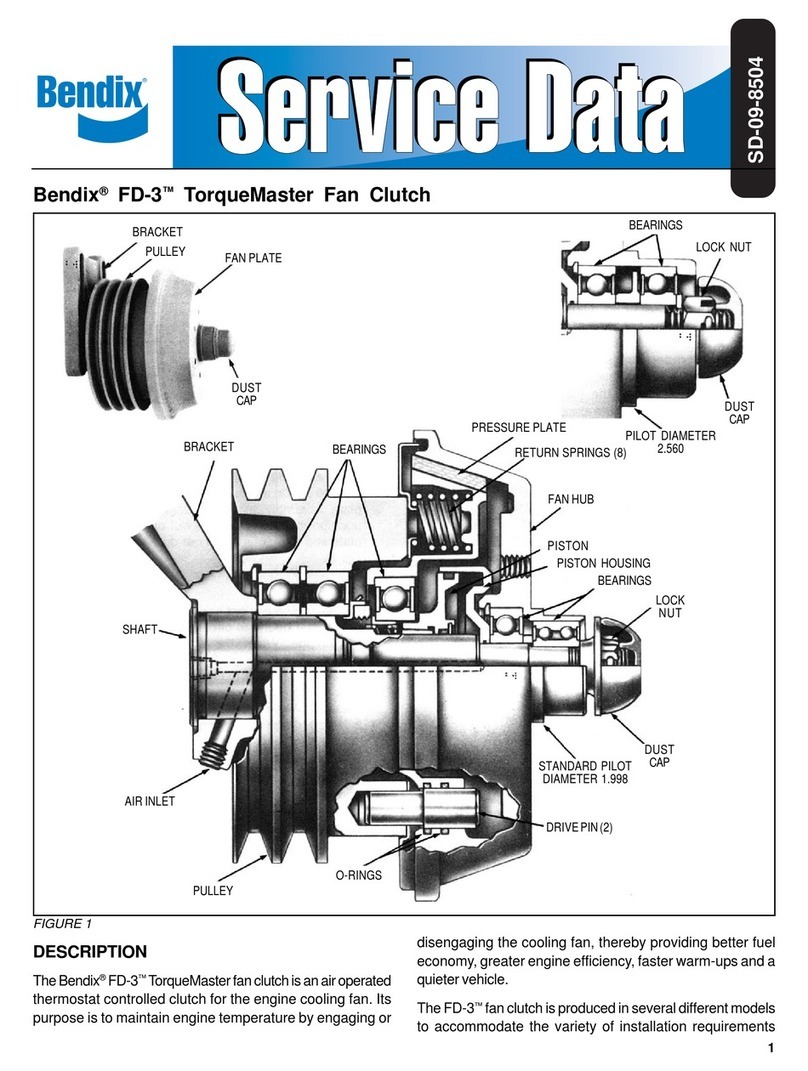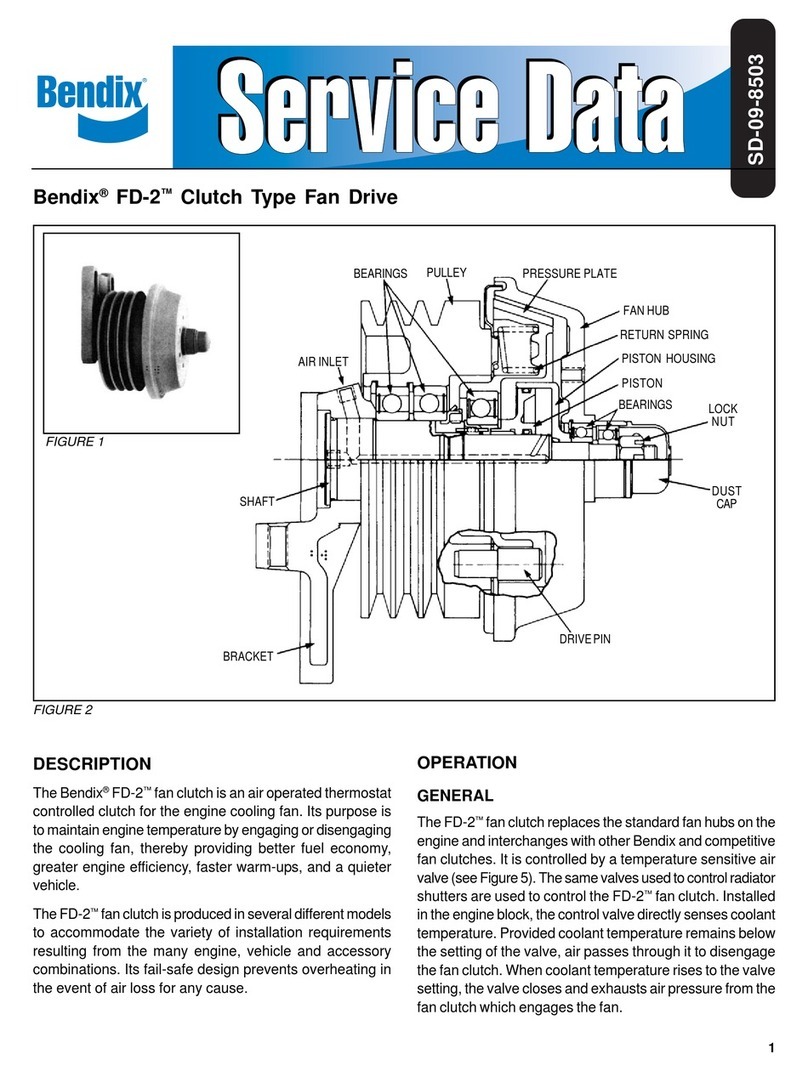
7
o-ring (14). Slide bearing retainer/piston assembly in
placeovershaft.Makesuretheindexingfinger onpiston
(13) is aligned with the corresponding gap in the side
wallof pistoncup(8). Push thepressureplate assembly
all the way home until the piston bottoms in the piston
housing.
3. Installspacer(5), spring (4), spring retainer (3), washer
(2) and cap screw (6). A new cap screw should always
beused (becauseofthe coatingonthe threads).Torque
the cap screw to 300 inch pounds.
4. Apply air pressure in control port of bracket or shaft
(80-120psi). Thiswill extendthebearing retainer/piston
assembly so the pressure plate can be positioned and
thethreePhillipsheadscrews(10)startedandtorqued
to 40 in. lbs. (It may be easier to torque the Phillips
headscrewsifthe air pressure in the clutch is released
after the screws are started.)
TEST
1. With no air pressure applied, the gap between the
pressure plate edge and the pulley face line should be
.375in. ± .04.With120psi air pressureapplied,thegap
may be .526 in. maximum (see Fig. 9).
2. Withnoairpressureapplied,thetorquerequired torotate
the clutch must not exceed 150 in. oz.
3. With 70-75 psi applied, the pressure plate must rotate
freely, separate from the pulley.
4. Perform the leakage checks outlined in the manual.
5. Do not overtighten engine fan belts.
RETROFIT INSTALLATION INFORMATION
To determine which fan clutch piece number should be
purchasedwhen retrofitting existingequipment,consultthe
nearestauthorizedBendixpartsoutlet for assistance.
Completeinstallation instructions and piping diagrams are
packed with each FD-1™fan clutch.
It is recommended that only cooling fans approved by the
vehicle or fan manufacturer be installed on the FD-1™fan
clutch.
WARNING! PLEASE READ AND FOLLOW
THESE INSTRUCTIONS TO AVOID
PERSONAL INJURYOR DEATH:
When working on or around a vehicle, the following
general precautions should be observed at all times.
1. Park the vehicle on a level surface, apply the
parking brakes, and always block the wheels.
Always wear safety glasses.
2. Stop the engine and remove ignition key when
working under or around the vehicle. When
working in the engine compartment, the engine
should be shut off and the ignition key should be
removed. Where circumstances require that the
enginebe inoperation, EXTREME CAUTION should
be used to prevent personal injury resulting from
contact with moving, rotating, leaking, heated or
electrically charged components.
3. Do not attempt to install, remove, disassemble or
assemble a component until you have read and
thoroughly understand the recommended
procedures. Useonly the propertools and observe
all precautions pertaining to use of those tools.
4. If the work is being performed on the vehicle’s air
brake system, or any auxiliary pressurized air
systems,make certain todrain theair pressure from
all reservoirs before beginning ANY work on the
vehicle. If the vehicle is equipped with an AD-IS™
air dryer system or a dryer reservoir module, be
sure to drain the purge reservoir.
5. Following the vehicle manufacturer’s
recommendedprocedures, deactivatethe electrical
system in a manner that safely removes all
electrical power from the vehicle.
6. Never exceed manufacturer’s recommended
pressures.
7. Never connect or disconnect a hose or line
containing pressure; it may whip. Never remove a
component or plug unless you are certain all
system pressure has been depleted.
8. Use only genuine Bendix®replacement parts,
components and kits. Replacement hardware,
tubing, hose, fittings, etc. must be of equivalent
size, type and strength as original equipment and
be designed specifically for such applications and
systems.
9. Components with stripped threads or damaged
parts should be replaced rather than repaired. Do
not attempt repairs requiring machining or welding
unless specifically stated and approved by the
vehicle and component manufacturer.
10. Prior to returning the vehicle to service, make
certain all components and systems are restored
to their proper operating condition.




























